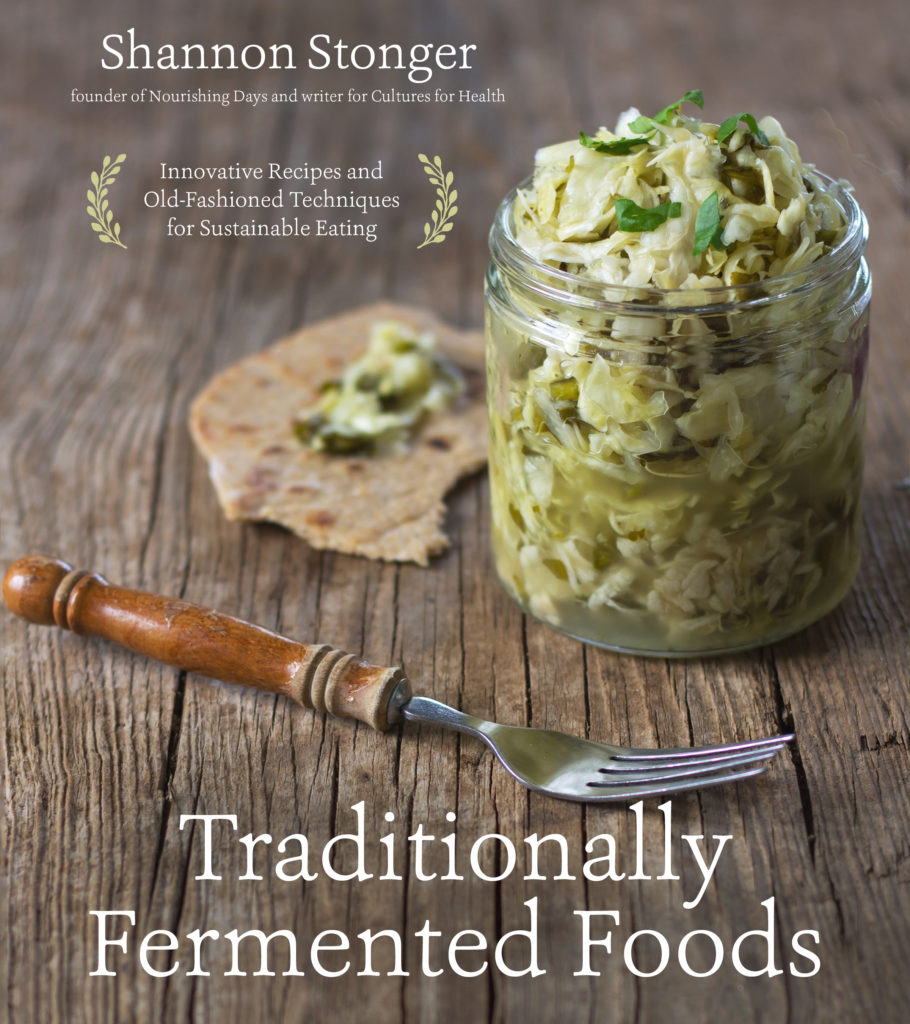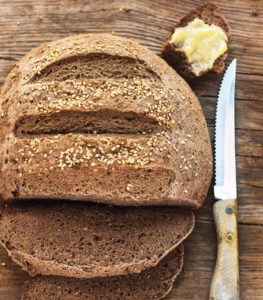This post may contain affiliate links which won’t change your price but will share some commission.
Most of us who have a health consciousness realize that we need more fermented foods in our lives. Sometimes there is a disconnect between our knowledge and practice though. This is certainly true in my life, but I continue to strive to increase the fermented foods in the diet of my family. The book Traditionally Fermented Foods by Shannon Stonger is a wonderful tool in this quest.
(I did receive an advance copy of this book in exchange for my honest review. This post contains an affiliate link at the end which will benefit me if you purchase through my link.)

This cookbook has 6 sections. She starts with a explanation of the basic fermentation process and the benefits and how to of fermenting foods.
The second section focuses on vegetables and includes recipes for taco kraut, pizza green beans, and fruit kraut. Shannon Swindler also has a really helpful section to me on how to avoid mushy ferments (a problem I have had) and equipment to use for the best possible results.
The second section is on fermenting grains and this was the one I got most excited about. I have been a sourdough fan for a long time and have a whole sourdough section here on this website. As someone who has recently adopted a low-carb, high-fat diet I am not really eating bread anymore, but my children still are. Two of my children are gluten free and one of those is extremely sensitive to any kind of gluten, even that in sourdough. Traditionally Fermented Foods has a number of sourdough recipes, including about half of them for gluten free sourdough. We made the GF sourdough English Muffins and most of my family was very impressed. We also tried the GF sourdough rolls and really liked them too. They were easy to make and came out tasting good and not crumbly at all. One of our favorite recipes is the Gluten-Free Sourdough Seeded Country Loaf. I am sharing that recipe below.
The third section is on fermented dairy with recipes for kefir, yogurt, sour cream and feta cheese and some other recipes with how to use these wonderful forms of dairy.
The fourth section is on fermented beverages. My family regularly drinks water kefir, kombucha, and jun so these are already a regular part of our lives. Shannon Swindler gives some ideas on some fun things to do with these drinks and some other things like a root beer and ginger ale syrups to go with any other fermented drink so we plan to make these this summer to go with our kefir or kombucha. We don’t miss sodas at our house because we have so many great healthy options of what we can drink.
The last section is on fermented condiments. Recipes include fermented hot sauce, fermented garden salsa (something I am trying once my tomatoes and peppers from the garden are ready in August and September. The cultured dairy ranch dressing also looks wonderful. All these recipes have lovely images with them, something which is important to me in a cookbook. When I see a beautiful image of a recipe that seems of interest, it can be the tipping point to whether I make it or not.
I got permission to share the recipe for the Gluten Free Sourdough Seeded Country Loaf as this was one of my favorite recipes that I tried.
Gluten-Free Sourdough Seeded Country Loaf
This recipe is wholesome and simple enough to be your daily bread. After an overnight bulk ferment, it gets a couple of hours before being baked. My favorite part of this loaf is its keeping quality and how well it slices up for toast.
Makes: One large loaf.
Fermentation Time: 9 1/2 to 14 hours
- 1 cup water
- 3/4 cup gluten-free sourdough starter
- 2 tbsp honey
- 2 tbsp oil
- 3 tbsp ground flax seed
- 2 tbsp ground psyllium husk
- tbsp chia seeds
- 1 cup teff flour
- 3/4 cup tapioca flour
- 1/2 cup sorghum flour
- 1/2 cup millet flour
- 2 tsp sea salt
Directions:
In a large mixing bowl, whisk together the water, starter, honey, and oil. In a separate bowl, whisk together all dry ingredients. Add the dry ingredients to the wet ones and mix with a wooden spoon or clean hands for approximately 3 minutes. At this point, the dough will still be quite moist.
Cover and allow to bulk ferment for 8-12 hours or overnight.
Grease a baking sheet and uncover the dough. Knead the dough a few times and shape it into a large boule. Place on the prepared baking sheet and cover lightly with a damp towel. Allow to rise 1 1/2 to 2 hours, until puffed up slighly. During the last half hour of rise time, preheat the oven to 400 F.
Once it is risen, place the bread in the oven and bake for 55 to 65 minutes or until the internal temperature reaches 190 F. Allow to cool for 5 minutes before moving to a cooling rack. Let the loaf cool completely before slicing.
Directions for a sourdough starter are also included in the cookbook. Essentially a sourdough starter is a slurry of flour and water that takes about a week to grow together before use. Shannon Swindler recommends teff, buckwheat, or buckwheat to make a good flour. Start with 1/2 cup gf flour and 1/2 cup water. Mix vigorously to incorporate air. Cover with a clean cloth, paper towel, or coffee filter and secure 1 quart jar with a rubber band. Leave at room temperature for 12 hours. Repeat feedings with the same amounts of flour and water every 12 hour for 3 days.
Days 4 through 7 you continue to feed the starter every 12 hours, but discard half of the starter before every feeding. You should be seeing more yeast activity in this time. At about the six to seven day mark, your starter should indicate signs of being ready to leaven breads. Look for active, bubbly, doubling starter with a pleasant sourdough aroma. At this point you can bake with it, feed it again, and then continue with the maintenance part or your choosing.

I recommend this book for anyone who wants to do more with fermentation. It is a beautifully done cookbook with some lovely recipes, which will inspire you to healthier cooking and eating. To get your own copy, use my affiliate link at Amazon. You won’t regret it.

Leave a Reply